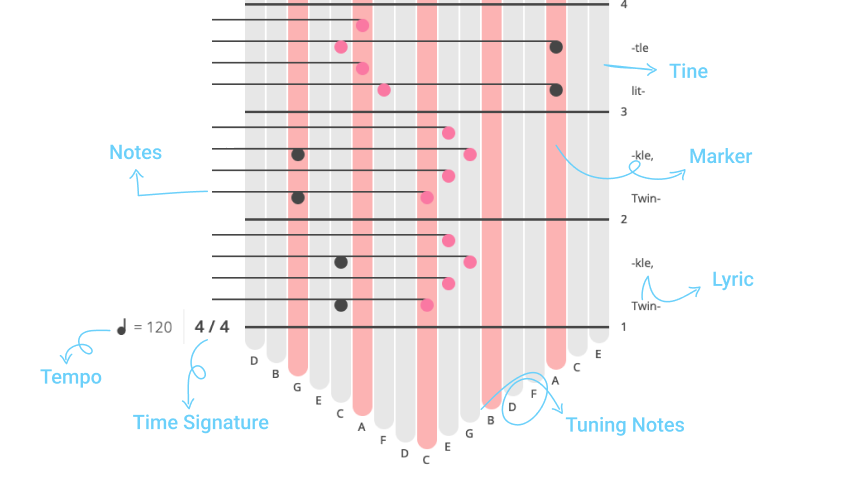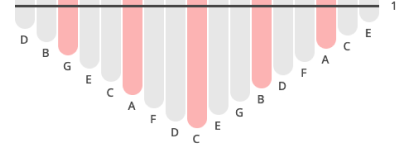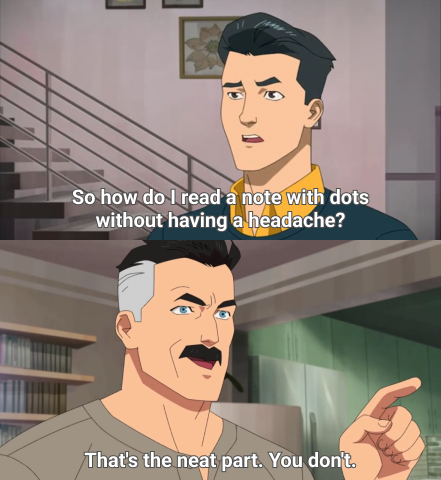"Those vertical kalimba tabs are hard!" you might be thinking. "I just wanted to learn a few songs, not the whole music theory." There is too much complexity going on a kalimba tab, and without prior music knowledge, reading it can be very challenging.
But, like many things in life, the difficulty comes from not being familiarized with it. This guide has everything you need to know about kalimba tabs. It's the guide I wish I had read when I started learning kalimba. So, without any further ado, let's get started!
What is a Kalimba Tab
A kalimba tablature (tab) is a way of representing a song on a kalimba. It contains song notes, their duration, and the location on the kalimba (the pitch). Bear in mind that the bottom of the tab generally has information about the song, like tuning, tempo, and the time signature.

Below you will find a real, playable kalimba tab! Click on the play button to see it in action.
What is the Tuning of a Kalimba Tab
The first seven letters of the alphabet name the music notes (pitches): A, B, C, D, E, F, and G. Each kalimba tine has a corresponding music note. Together, these notes indicate the tuning of the instrument. The most common kalimba tuning is the C major, formed by C, D, E, F, G, A, and B notes.
You can see the C major tuning in the image below. Note that the kalimba is tuned in an alternate pattern: C in the middle, D on the left, E on the right, F on the left, and so on.

Depending on your kalimba tuning, the notes will be different. For example, a G major tuned kalimba has the G, A, B, C, D, E, and F# notes.
"Hm... F#? What is that?"
The # on F# is called sharp. The A, B, C, D, E, F, and G notes are not all music notes that exist. The real ones are A, A#, B, C, C#, D, D#, E, F, F#, G, and G#. These notes are one semitone or half step away from each other. The semitone is the smallest musical interval used in western music; It means there cannot be a note between A and A#, for example, because they are one semitone apart. When you write a music note with sharp # in it, what you mean is: take this note and add one semitone to it. The sound produced will be higher than the original note.
Now that we cleared it out, let's add a different way of writing the notes: the flat. Flats are represented by the lowercase b letter. Using a flat on a note means subtracting one semitone from it. The result will be a music note lower than the original one. So, the real ones using flats are A, Bb, B, C, Db, D, Eb, E, F, Gb, G, and Ab.
Sharps and flats on a music note are called accidentals.
"Great... But why is there no Cb, Fb, B#, and E# notes?"
That's a great question. When you put a flat on a C note, you want a note half step lower than C. And, guess what, this note already exists: It's the B note 🤯. In other words, Cb = B. The same happens to the other notes, Fb = E, B# = C, and E# = F.
How to Find the Tuning of a Kalimba Tab
The tuning depends on the notes the kalimba can produce. Generally, Kalimbas are tuned on major scales. The most common tuning is the C major. To find out the tuning, check the notes on the table below.
| Scale Name | Notes |
|---|---|
| C major | C D E F G A B |
| C# major | C# D# F F# G# A# C |
| D major | D E F# G A B C# |
| D# major | D# F G G# A# C D |
| E major | E F# G# A B C# D# |
| F major | F G A A# C D E |
| F# major | F# G# A# B C# D# F |
| G major | G A B C D E F# |
| G# major | G# A# C C# D# F G |
| A major | A B C# D E F# G# |
| A# major | A# C D D# F G A |
| B major | B C# D# E F# G# A# |
What is a Note on a Kalimba Tab
A note on a Kalimba Tab contains two pieces of information: the pitch and the duration. The pitch is just the note name, and you can find it at the start of the tine. The duration is the amount of time to play the note. In music theory, all the durations are represented in fractions of base 2. The biggest duration is the whole (1) note. The next one is the half note (1/2), then the fourth (1/4), the eighth (1/8), and so on.
"Got it! But what if there is no note to be played?"
The pause between notes is called rest. The rests also follow the same fraction logic, but the visual representation is not intuitive. Here is a helpful table with all these durations:
| Duration | Name (US) | Name (UK) | Note Symbol | Rest Symbol |
|---|---|---|---|---|
| 1 beat | Whole | Semibreve |  |  |
| 1/2 beat | Half | Minim |  |  |
| 1/4 beat | Quarter | Crotchet |  |  |
| 1/8 beat | Eighth | Quaver |  |  |
| 1/16 beat | Sixteenth | Semiquaver |  |  |
| 1/32 beat | Thirty-second | Demisemiquaver |  |  |
| 1/64 beat | Sixty-fourth | Hemidemisemiquaver |  |  |
Understand by Playing
That was a lot of information! Congratulations for reading this far 🥳
Below you will find a playable kalimba tab with almost all the notes we have just studied in order of duration. Click on the play button to see the theory in practice.
Other Note Durations: Dots
What if you need to play the notes a little longer, but not as long as the next duration? It is the perfect job for the dots. When you add a dot to a note, you are increasing its duration by half. So, in the end, you will have a duration 1.5 times longer than the original duration. Let's see a few examples:
- There is a half note (1/2), you add a dot, it becomes 1/2 + (1/2)/2 = 1/2 + 1/4. You'll play for the duration of a half + a quarter.
- There is an eighth note (1/8), you add a dot, it becomes 1/8 + (1/8)/2 = 1/8 + 1/16. You'll play for the duration of an eighth plus a sixteenth.
"Great, now I have to do some math. Could it be more difficult?"
You bet! What if you add two dots? The first dot adds half (1/2) of the note duration, the second dot adds a quarter (1/4) of the note duration. Essentially you will have a duration 1.75 times longer than the original duration. Look at this example:
- There is an eighth note (1/8), you add two dots, it becomes 1/8 + (1/8)/2 + (1/8)/4 = 1/8 + 1/16 + 1/32. You'll play an eighth plus a sixteenth plus a thirty-second duration. Or maybe you won't, who adds two dots to a note anyways? 🧐

Here is a nice playable tab with dots. Pay attention to the number of eighth notes on each measure:
- First, we can add four eighths.
- After adding a dot, we can add just two eighth notes (half of what we could before).
- After adding two dots, we can only add one eighth note (a quarter of what we could before).
Other Note Durations: Tie
"There is more? I thought it was over!"
Don't worry. The tie is very easy to understand. When you tie two or more notes, you will play the note just once, and the duration will be the sum of the tied notes' durations. A few examples:
- You tie a quarter (1/4) note with a half (1/2) note. You will play the note just once with 1/4 + 1/2 duration.
- You tie a half (1/2) note with a whole (1) note. You will play the note just once with 1/2 + 1 duration.
- You tie a half (1/2), a quarter (1/4), and an eighth (1/8). You will play the note just once with 1/2 + 1/4 + 1/8 duration.
Easy, right? Here is a playable example:
How to Play Notes on the Same Row on a Kalimba Tab
When there are notes on the same row, you should play them together. Draw a mental line that vertically divides the kalimba in half. Now, check how the notes are placed:
- There is a note on the left side and one on the right side: You will play at the same time using your two thumbs.
- There are two, three, or more notes right next to each other: You will slide your nail through all of them. Place your thumb's nail on the lowest note and slide it up until you play the last note. This technique is called glissando.
- There are two notes on the same side, but they are not next to each other: You will play with your two thumbs. The hand on the notes' side will play the nearest note to it. The other hand will play the other note. It is quite hard, as the hand on the opposite side will have to stretch to reach the note.
Here is a tab with a few examples. Try to play them on your kalimba.
What are Measures on a Kalimba Tab
"Seeing all these tabs is great and all, but what are those lines dividing the rows?"
Those lines divide two measures. A measure is a set of notes on a tab, and the duration of a measure is the same as all the other measures on the same time signature. The time signature tells how many notes there should be in a measure, and what is the duration of those notes. It's divided into two numbers: the first one is for the number of notes, and the second one is for the duration. Here are a few examples:
- A 4/4 time signature means you can fit 4 notes of a quarter (1/4) duration on each measure.
- A 3/8 time signature means you can fit 3 notes of an eighth (1/8) duration on each measure.
- A 2/16 time signature means you can fit 2 notes of a sixteenth (1/16) duration on each measure.
Let's go back to the kalimba tab example with the notes we have studied. It has a 4/4 time signature, so the duration of each measure is 4 * (1/4) = 1. We can fit a whole (1) on a measure, or two halves (1/2), or four quarters (1/4), and so on. Here is the tab again:
Now, compare it to this other tab. It has a 3/8 time signature. The duration of each measure is 3 * (1/8). We can fit three eighth (1/8) notes on a measure, or one quarter (1/4) and an eighth (1/8), and so on.
What is a Repeat on a Kalimba Tab
When there are measures that are played repeatedly, it's more convenient to write them once and add repeat symbols to them. The 𝄆 symbol means the measure will be repeated, and this is where the repetition starts. The 𝄇 symbol means the repetition ends there. Combining both of them 𝄇𝄆 means it's the end of repetition and a start of a new one. Here is an example:
What is Tempo on a Kalimba Tab
Now, let's talk about speed. How fast should you play the tab? That's a question for the tempo. The tempo is represented using Beats Per Minute - BPM. The more beats per minute, the faster it is! A few examples:
- ♩ = 120 BPM means there will be 120 quarter note beats in a minute.
- ♪ = 60 BPM means there will be 60 eighth note beats in a minute.
"What if the BPM is an ugly number? How will I know how to play?"
Using a metronome! There are plenty of metronome apps out there, but the simplest one is just using Google's built-in metronome. Enter the BPM then hit play.
Here is a kalimba tab with a fast tempo:
Now what?
If you've read this far, congratulations! 🥳. Now you are ready to read and even write kalimba tabs with confidence! If you would like to learn kalimba songs just like those examples, go to TabWhale. You'll find a lot of kalimba tabs there! You can also create your kalimba tabs for free!
If you found this article helpful
You will love these ones as well
About TabWhale
What is TabWhale? Is it about tabs, whales, or something else? Is it a kalimba website? Find out in this post.
Read moreHow to Read Number and Letter Kalimba Tabs
Number and letter tabs are two notations used to represent kalimba tabs. Learning them is pretty easy! This guide has everything you need to know about it.
Read more